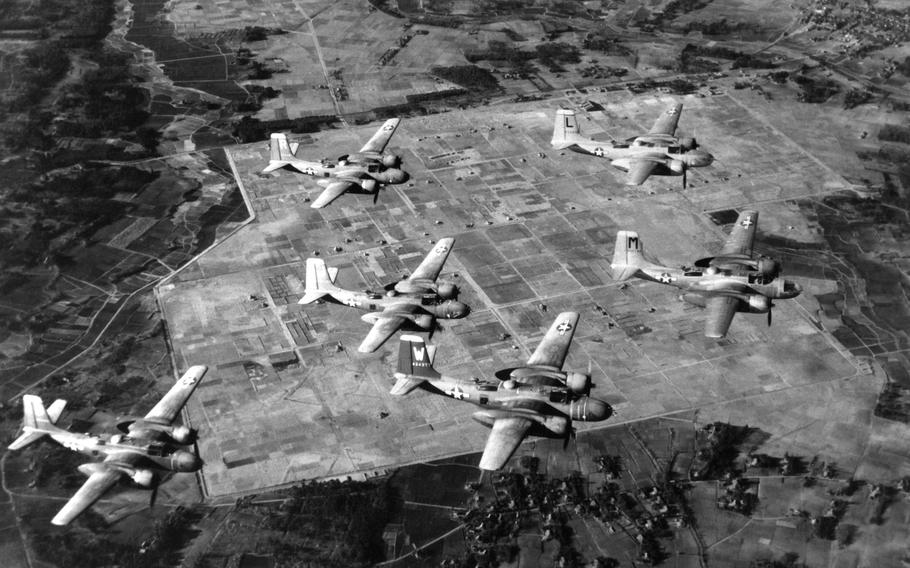South Korea and the United States have launched a collaborative underwater mission aimed at locating and retrieving the remains of a US bomber and its crew that were lost during the Korean War.
The operation, involving 22 divers and underwater archaeologists, aims to locate a B-26 Invader that crashed off Haeundae Beach in Busan in January 1953.
The search, which began on September 3, is a collaboration between the U.S. Defense POW/MIA Accounting Agency (DPAA) and South Korea’s Agency for Killed in Action Recovery Identification (MAKRI).
The effort is focused on finding the remains of three American servicemen who were aboard the bomber when it crashed shortly after taking off from the K-9 air station in Busan.
Yonhap, citing a news release from South Korea’s Ministry of National Defense, reported that the teams are employing sonar equipment and magnetic detectors to search a 4.6 square-mile area of water.

The operation is set to continue until September 27, with support from South Korea’s Navy and Coast Guard, who are providing weather information and logistical assistance.
This mission follows a similar joint operation conducted last year by the U.S. and South Korea. Although the previous attempt did not yield significant results, the two countries are determined to continue their efforts this year.
DPAA team leader Patrick Hennessy emphasized the mission’s importance, stating, “If there is even a faint possibility, we will not give up and focus on all of our capabilities.”
The recovery project is not only about honoring the fallen but also about strengthening the partnership between the US and South Korea.
MAKRI manager Lee Gueun-won highlighted that the operation underscores the commitment to honoring those who “protected the freedom and prosperity” of South Korea.
During the Korean War, over 1.7 million US troops were deployed to the Korean theater, with more than 36,000 losing their lives, according to data from the UN Command.
The collaboration between the US and South Korea in recovering the remains of American soldiers killed during the Korean War dates back to 2011. Since then, nearly 700 US service members have been accounted for, though approximately 7,460 remain missing, according to the DPAA.
Performance Of The B-26 Bomber In Korean War
Originally designated the A-26, the B-26 Invader served as an attack aircraft during World War II, performing level bombing, ground strafing, and rocket strikes.
However, in 1948, the A-26 was renamed the B-26, leading to confusion with the Martin B-26 Marauder from World War II. The Douglas B-26 Invader was a three-seat, twin-engine light bomber used by the US Air Force during the Korean War.
It had the capacity to carry up to 4,000 lbs of internal ordnance and 2,000 lbs of external ordnance. Equipped with ten 0.50-inch machine guns—six in the nose, two on the dorsal side, and two on the ventral side—the B-26 Invader was powered by two 2,000-hp engines, enabling it to reach speeds of up to 355 mph, making it the fastest US bomber of World War II.
At the onset of the Korean War, the Far East Air Forces had 26 operational B-26s assigned to two squadrons within the 3rd Bombardment Group.
These forces were quickly bolstered, and by November 1950, two groups of B-26s, each comprising three squadrons, were operating under the US Fifth Air Force. Throughout the Korean War, B-26s completed 55,000 sorties, including both the initial and final US bombing missions of the conflict.
The crews of the Third Bomb Group (Light) and the 452nd (later the 17th) Bomb Group (Light) utilized their B-26s to target enemy supply lines and transportation networks.
Initially, these interdiction missions were conducted during the day, but increasing enemy anti-aircraft fire and the threat from Soviet-made MiG-15s forced them to shift to nighttime operations.
A B-26 Invader from the 3rd Bombardment Group was among the first American aircraft to engage in the Korean War, conducting missions over South Korea on June 27 and 28 before the USAF’s first strike on North Korea, targeting an airfield near Pyongyang.
The aircraft were later moved to Pusan East (K-9) Air Base in early 1951, continuing their day and night intruder missions. By June 1951, they joined the 3rd Bomb Wing (Kunsan (K-8)) for exclusive nighttime operations, with the 452nd and the 3rd sharing target areas.
Despite one bomber crashing shortly after taking off from K-9 Air Base, the B-26 Invader’s performance was highly praised. The aircraft received the Korean Presidential Citation and two unit citations for their wartime contributions and were credited with eight highly successful campaigns.
- Contact the author at ashishmichel(at)gmail.com
- Follow EurAsian Times on Google News